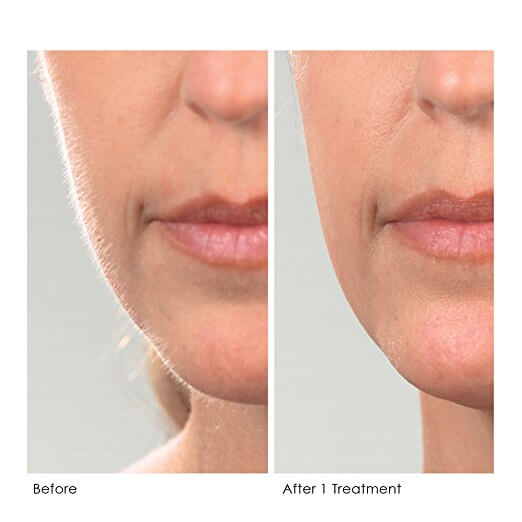People are shaving their faces?? Yes, but Dermaplaning is so much more. The treatment is like a peel and hair removal in one and the best part – it’s painless!
Turn Back The Clock On Your Skin!
Dermaplaning is like exfoliation on steroids, but soft and relaxing. The procedure involves using a 10-inch sterile surgical scalpel to gently remove the top-most layer of dead skin along with fine, vellus hair (peach fuzz), leaving your skin brighter, smoother and more radiant than ever before.
Besides the short-term effects of glowing, baby’s bum skin, the long-term effects are amazing as well. Increased cell turnover, fewer wrinkles and dark spots, reduction of acne scarring, and the removal of fine facial hair that a laser can’t get.
Dead skin build up from oil, dirt and hairs, prevents new cells from surfacing, clogs your pores and can cause uneven skin texture and tone, leaving your skin looking dull and lifeless. Dermaplaning triggers the cell regeneration process and improves the appearance of acne scarring, hyperpigmentation and fine lines. Your skin care products and treatments are able to penetrate the skin much more effectively, saving you time and money. Your makeup will also go on and blend smoother, giving you a flawless complexion and making this the number 1 treatment before a big event!

Disclaimer: Individual results may vary
Book Your FREE Consultation Today in our Vancouver Laser Clinic!
How does Dermaplaning work?
Monthly Promotions
Shop the latest monthly deal at Nuage Laser, covering a broad range of treatments.
learn more
FAQ
What is dermaplaning?
A: Dermaplaning is a physical form of exfoliation, using a sterile, surgical scalpel to gently shave the skin’s surface, removing the top layer of dead skin along with fine vellus hair, improving the appearance of things like scars and dark spots, in order to reveal a smooth and a radiant complexion.
Who’s a candidate for dermaplaning?
A: Dermaplaning is safe and effective for all skin types and colors and provides an alternative to chemical peels or microdermabrasion. It is a good choice for anyone who has fine facial hair, acne scars, fine lines, extremely sensitive or dry skin, redness or rosacea, or visible facial veins. Dermaplaning cannot be performed in individuals with active acne.
How many treatments will I need? How often is treatment done?
A: The number of treatments varies based on the condition(s) being addressed. As dermaplaning is the most intense form of exfoliation, patients will see immediate results, such as glowing, brighter skin, reduction in dark spots and no more peach fuzz. For those looking to treat more permanent conditions such as sun damage, fine lines and pore size, 3-6 treatments every 4-6 weeks are recommended and then regular maintenance treatments to keep the best skin.
Can dermaplaning be combined with other treatments?
A: Yes, and it is even encouraged. As dermaplaning enhances the efficacy of products and treatments by removing the top layer of dead skin (which blocks penetration), treatments like Microneedling, Laser Genesis and Chemical Peels get optimal results in combination. Combined exfoliation treatments promote healthy skin cell turnover, prevent acne, reduce dark spots and blemishes, and boost collagen production for plumper skin.
Is dermaplaning painful? What can I expect during my treatment?
A: Not at all! Dermaplaning is completely painless and is actually very gentle and relaxing. The blade just scrapes at the top layer of skin and never actually cuts you.
When you come in for your dermaplaning treatment, we’ll start with a very relaxing facial cleanse to clear your skin of any debris and calm you. We’ll then start the process of pulling your skin taught and gently ‘shaving’ your face with the scalpel to take off the peach fuzz and any sun damage. Multiple passes may be necessary, depending on the skin’s individual needs.
Will my facial hair grow back thicker?
A: No, absolutely not! This is the most common misconception of dermaplaning. Your facial hair will not grow back any thicker or darker than it was. Often patients feel like it has, because the hair has been cut at the thickest part of the hair and is all growing back at the same rate, making a definite contrast to how it felt initially after the treatment.
What conditions can be treated or improved with dermaplaning?
A: In addition to treating a variety of conditions, dermaplaning also improves the efficacy and penetration of topical products, stimulates circulation and collagen production, produces a smooth texture and clear complexion ,and, unlike many other resurfacing procedures, dermaplaning works on all skin types.
Conditions that can be treated with dermaplaning include:
- Acne scars
- Fine lines and wrinkles
- Uneven skin tone
- Sun damage or hyperpigmentation
- Enlarged pores
- Dry or rough skin
- Enlarged pores
- Unwanted facial hair
Dermaplaning is NOT recommended if you are experiencing any of the following:
- Inflamed acne
- Severe melasma
- Skin cancer on face
- Active cold sores
- Dermatitis including eczema and/or psoriasis
- Open skin lesions
Is there any downtime after dermaplaning?
A: There is no downtime for this “lunch hour” procedure, and most patients return to their regular activities immediately, because dermaplaning is non-invasive and is one of the safest skin rejuvenation procedures available. Some patients report redness or dry feeling in their skin after a treatment, but this is temporary. Very rarely the skin can be nicked, but this typically heals almost on the spot. Typical care following your treatment includes the use of ZO Skin Health products and sunscreens, and avoiding sun exposure for a few days.
